When I was a kid, downy woodpeckers were common visitors to our suet feeders and the platform feeder that held black sunflower seeds on the front porch. So, I had lots of opportunities to watch them. They were probably the second species of woodpecker that I learned to identify. (The first woodpecker species I learned to identify was the pileated woodpecker, which is so distinctive that it is hard to get it mixed up with anything else.) Even now, many years later, I still enjoy watching downy woodpeckers.
How to identify downy woodpeckers
The downy woodpecker (Dryobates pubescens) is the smallest woodpecker in North America. A downy woodpecker is typically between 5.5 and 7 inches long from the tip of its bill to the tip of its tail. That’s about the length of a dollar bill, give or take a bit. Or to give another size reference, a little bigger than a Carolina wren, but quite a bit smaller than a cardinal.
They are primarily black and white. The belly is bright white, along with the middle of the back. The wings are black with white speckles. The upper surface of the tail has white feathers on the outer sides and black feathers in the middle. If you can see the underneath side of the tail, it will be white and with black spots or stripes.
The face is mostly white with a black bridle formed from black stripes extending along the top of the head, through the eyes, and dropping from the corner of the mouth down to the shoulder. The males have a red spot on the back of their heads, while females lack the red. Immature birds of both sexes lack the red spot on the back of the head and instead have a red spot between their eyes.
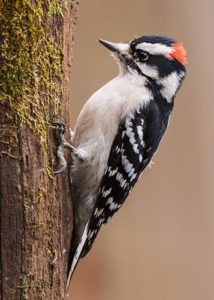
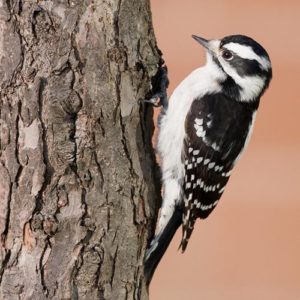
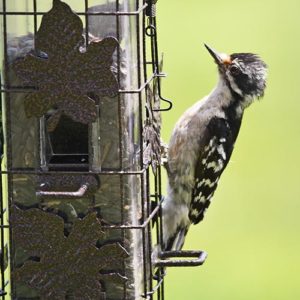
Note: Hairy woodpeckers can also be found throughout most of North America and look very similar to downy woodpeckers. However, hairy woodpeckers are significantly larger – usually somewhere between carinal-sized and robin-sized. In the eastern U.S., they also tend to lack the black spots / stripes on the underside of the tail and instead typically have a solid white underside of the tail. Admittedly, it can be difficult and sometimes frustrating to tell downy and hairy woodpeckers apart, but keep trying. Once you “get it,” it starts to become much easier.
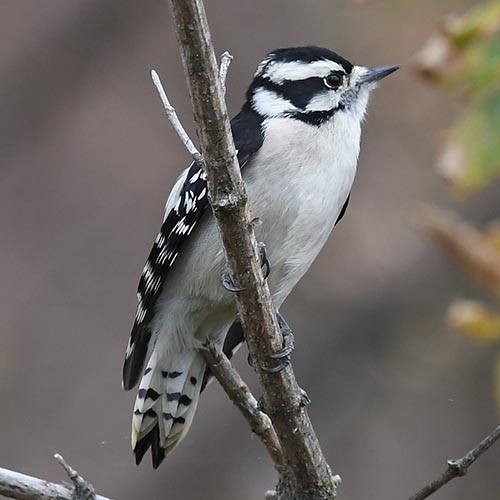
Where to find downy woodpeckers
Downy woodpeckers can be found year-round in open, deciduous woods throughout most of North America. They are also common visitors to urban and suburban yards or winter bird feeding stations, especially when there are a few trees around.
Basic biology and life history
Downy woodpeckers form pair bonds in late winter. In the early spring, both the male and female excavate the nesting cavity which is often found in a dead branch. Creating the nesting cavity can take 2-3 weeks and they typically create a new nesting cavity each year. Nesting cavities from previous years are used by a variety of other cavity nesting birds and animals.
After completing the nesting cavity, the female lays 3 – 6 eggs. Both the male and the female take turns incubating the eggs for approximately 2 weeks until the eggs to hatch. Both parents also feed the nestlings. The nestlings typically leave the nest at approximately 3 weeks old, but may follow the parents around for another few weeks.
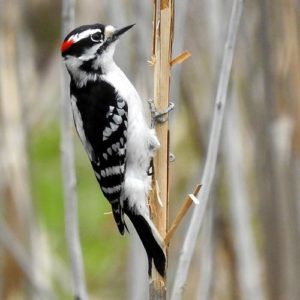
Like most woodpeckers, downy woodpeckers primarily eat insects. However, its small size allows it to take advantage of feeding locations that aren’t available to larger woodpeckers. In addition to the “normal” woodpecker feeding locations such as on tree trunks and branches, downy woodpeckers often forage along the stems of tall flowers where they go after larva buried in the stem or developing in galls. (They are a common predator of goldenrod apple galls.)
Downy woodpeckers also commonly go after the mud dauber nests on my porches. In fact, that’s why I leave the mud dauber nests on my porch every year – they are some of my natural bird feeders.
In addition to insects, up to 25% of a downy woodpecker’s diet can be berries, seeds, and other plant material. This is one reason why they are one of the most common woodpecker visitors to bird feeding stations. Occasionally they’ll even visit hummingbird feeders and drink nectar out of the ports.
Downy woodpeckers, like other woodpeckers, don’t have a true song. Instead, they have a chattering call. They also communicate through drumming on hollow wood or metal. Both male and female downy woodpeckers will drum.
They have several different types of drumming behavior depending on what they are trying to communicate. For most of those communication types, the woodpecker will search out the “perfect” spot which has the right pitch and resonance.
Attracting and observing
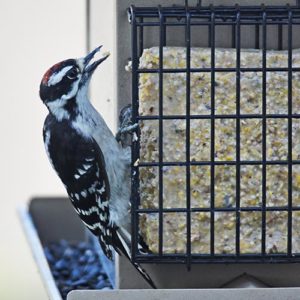
In the wild, you can find downy woodpeckers in most open, deciduous woods. They can often be seen moving up and down tree trunks or along the branches. During the winter, they may also be in mixed flocks with chickadees and titmice. Even in “less wild” areas, like urban and suburban yards or parks, as long as there are some trees around, there’s a good chance that a downy woodpecker might come through.
Downy woodpeckers are also the most likely woodpecker to visit a bird feeder, especially in the winter time. Hanging suet blocks, especially ones with berries in them, is a great way to attract downy woodpeckers on cold winter days. They’ll also likely take advantage of any black oil sunflower seeds you offer.
Summary
Downy woodpeckers can be fun birds to watch and listen to both in the woods and in your yard. If you put up a bird feeder with black oil sunflower seeds and suet during the winter, then there is a good chance that you will attract one of these cool little woodpeckers. It is often considered the most common woodpecker to visit backyards and feeders. And, since downy woodpeckers don’t migrate, once you get used to spotting them around your feeders during the winter, it will become much easier to spot them in other locations and at other times of the year.

Do you want to make your yard more pollinator and wildlife friendly, but aren’t sure where to start?
Check out my book, Attract Pollinators and Wildlife to Your Yard: 15 Free and Easy Ways, for some easy, quick wins to get you started.

Backyard Ecology: Exploring Nature in Your Backyard
Nature isn’t just “out there.” It’s all around us, including right outside our doors. Hi, my name is Shannon Trimboli, and I am the host of Backyard Ecology. I live in southcentral Kentucky and am a wildlife biologist, educator, author, beekeeper, and owner of a nursery specializing in plants for pollinators and wildlife conservation. I invite you to join me as we ignite our curiosity and natural wonder, explore our yards and communities, and improve our local pollinator and wildlife habitat. Learn more or subscribe to my email list at www.backyardecology.net.

Leave a Reply